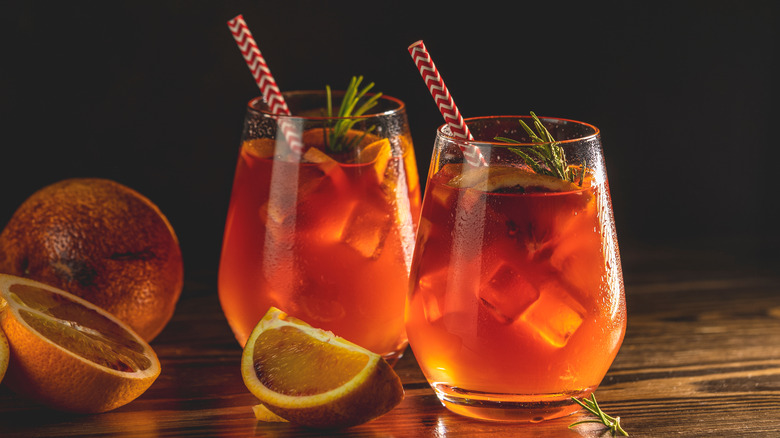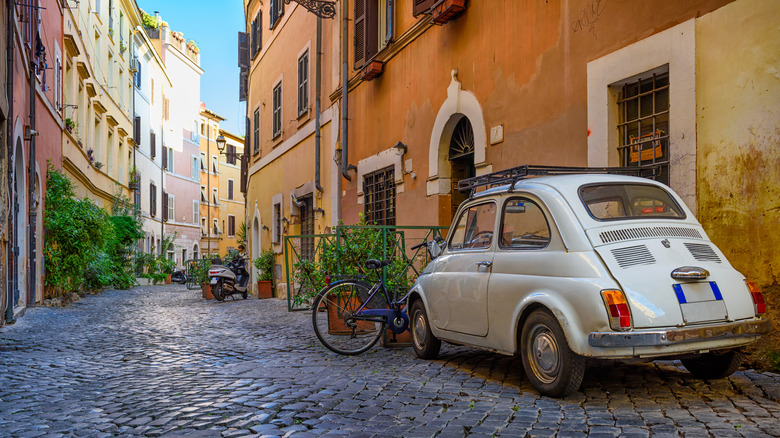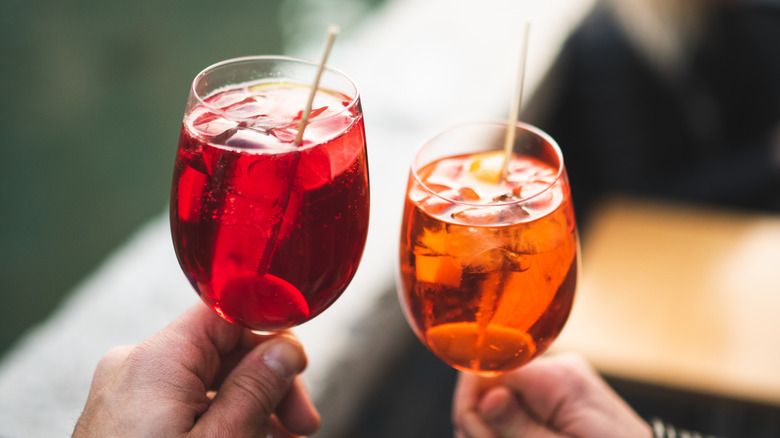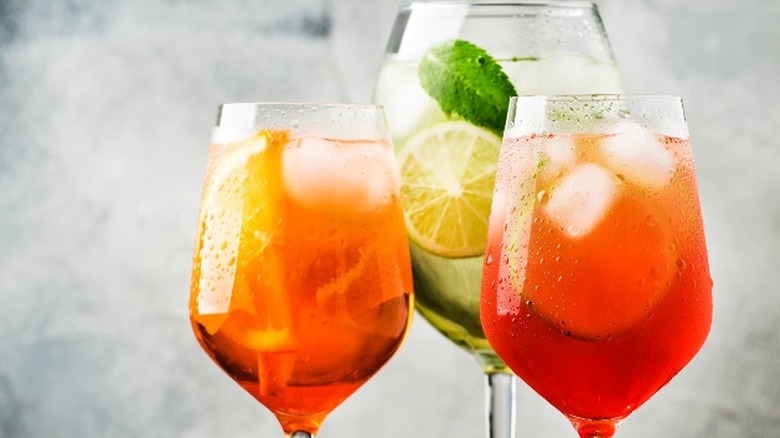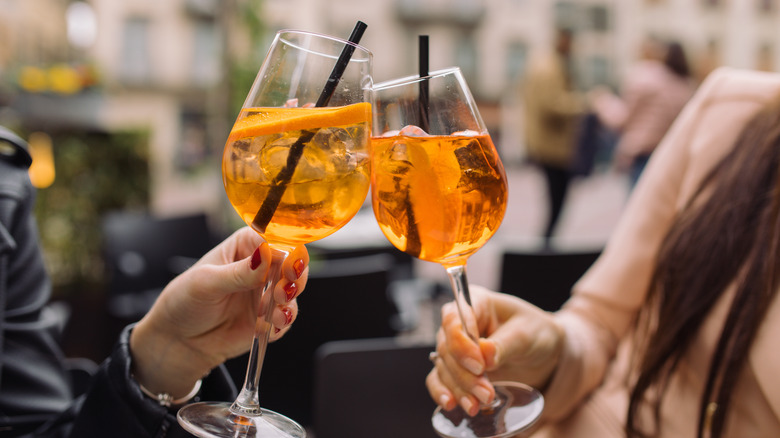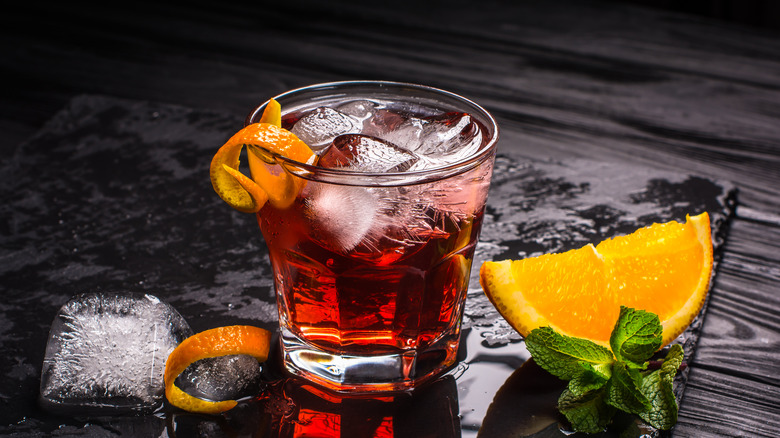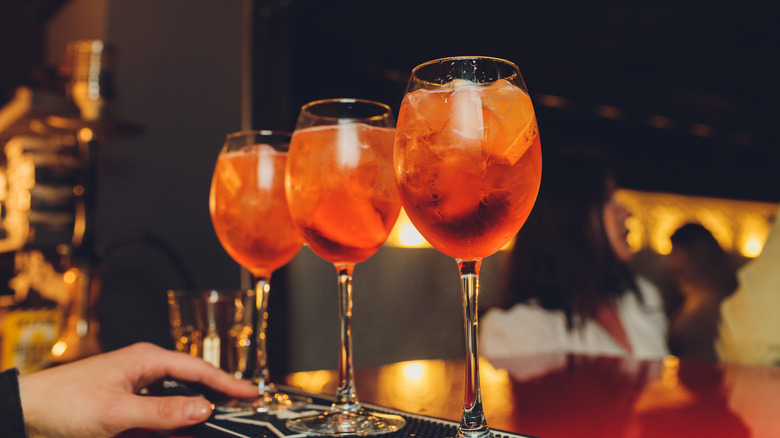The Real Difference Between Aperol And Campari
We may receive a commission on purchases made from links.
The tradition of stimulating the appetite via an aperitivo, or light alcoholic beverage, has centuries-old roots in Italy and remains a cornerstone of the culture today. According to Walks of Italy, the modern version of an aperitivo may stretch back to 1786, when a vermouth distiller advocated his concoction before meals (hence the term aperitivo, which has roots in the Latin word for "opener"). In a way, it's like the Italian version of an American happy hour, Walks of Italy explains.
Over the years, Italian alcohol inventors attempted to launch successors to the pre-meal drink throne. Milan-based Gaspari Campari introduced his eponymous bitter liqueur in 1860, followed decades later by brothers Luigi and Silvio Barbieri, who created Aperol in Padua, Italy in 1919, per Food & Wine.
Today, the two brands are often confused or used interchangeably as they share several key traits: vibrant hues, Italian origin, and flavors that blend both bitter and sweet, per MasterClass. But don't be fooled — there are distinct differences between the two popular apéritifs.
In Italy, Aperol began giving Campari a run for its money
While both Aperol and Campari have Italian roots, they were born 145 miles away and 59 years apart from one another, per Food & Wine. First came Campari, a namesake brand by Gaspare Campari, which was a hit from the very beginning — often looked at as the "it" liquor of Italy, per Campari. The company had its claws set into the hustle and bustle of Italian culture, especially in Milan where Camparino, the first Campari bar, was opened in 1867.
A liquor seven years in the making, Aperol made its debut in 1919, becoming an immediate fan favorite among younger adults in the Italian social scene. As time went on, Aperol picked up steam internationally and was commercialized in the 1950s.
Fast forward to 2003, and the Campari Group announced its acquisition of Aperol, bringing both under the same company umbrella. Smart move — like Campari, Aperol was showing steady growth in popularity as an established alcohol icon. And, in addition to being a key ingredient in the summertime staple Aperol Spritz, Aperol's lower alcohol content allows for delicious straight sipping. If Campari wanted to stay on top, this was the move they needed to make.
Battle of the hues: Aperol vs. Campari
Trying to distinguish an Aperol cocktail from a Campari cocktail can feel nearly impossible. Both liqueurs boast such vibrant orange hues that telling one another apart could come down to the taste (more on that later). However, Food & Wine points out that Aperol has more of a red-orange coloring, whereas Campari is more of a scarlet red.
So, how does Campari get a darker, more robust red hue? Well, you might be better off not knowing. According to The New York Times, Campari was using small crushed insects called cochineals for dye. Do not fret, as The Times assures this extraction process is quite normal, especially in other industries such as fabrics and cosmetics. Even so, Campari did end up switching to artificial coloring in 2006, which The Times notes was not due to any issues with using bugs as coloring, but rather "uncertainty of supply." It's unclear whether Aperol also relied on cochineals for its coloring; however, given the fact that the company is now owned by Campari, it's probably safe to say they aren't currently either.
Battle of the bitters: Aperol vs. Campari
If enjoyed straight, you can usually tell the difference between Aperol and Campari simply by looking at the color. But, things can look a little splotchy once ice and mixers are involved (or if you've had one too many). This is where taste comes in. Aperol combines the flavors of rhubarb, bitter herbs, and burnt orange, while Campari offers undertones of cherry, clove, rhubarb, cascarilla, cinnamon, and orange peel. Aperol is sweeter than Campari, which packs more intense bitterness.
Food & Wine adds that the contrasts continue when examining alcohol content, with Aperol clocking in at 11 percent ABV (15 percent in Germany) and Campari containing 20.5 to 28.5 percent, depending on the country where it's sold. Because Aperol has a lower ABV, it's more appropriate to sip straight; however, that doesn't mean you can't also enjoy a glass of Campari on the rocks. Either way, both liquors are relatively lower in alcohol content than other hard liquors such as vodka (40 percent ABV) or whiskey, rum, and tequila (40 to 46 percent ABV), according to Alcohol.org.
A Spritz isn't the only Aperol cocktail
As it has a lighter color, lower ABV, and higher sweetness factor than Campari, Aperol tends to be featured in lighter drinks, including the refreshing Aperol Spritz. The Aperol Spritz is made with "three parts Prosecco, two parts Aperol, and one part soda" over ice with an orange slice for garnish, per Food & Wine. Aperol has become increasingly popular not only in early-evening cocktails, but as a component in brunch drinks, because it is a lighter spirit. And hey, an Aperol Spritz isn't too far from a classic mimosa, when you think about it.
Town & Country recognizes Aperol as the liquor of summer, but if you do need a change-up from the ubiquitous Aperol Spritz, the magazine recommends one of these other punchy Aperol cocktails: Turbo Lover, made with coffee and chile liqueurs; MacNamara Rose, featuring Irish whiskey, Lillet, and cucumber; The Airedale, a simple combination of Aperol, bourbon, and simple syrup; or Maya Bay, reminiscent of a citrus-y margarita.
All the Campari cocktails you need to know
When you hear Campari, the first thing to come to mind is probably a Negroni. The signature Campari cocktail is made with one part gin, one part Campari, and one part semi-sweet red vermouth, poured over ice and garnished with an orange peel, per Gimme Some Oven. Unlike the Aperol Spritz, this boozy beverage is stronger and bitter, but equally as refreshing. The Boulevardier (a Negroni with bourbon instead of gin), Americano, Bitter Spritz and Jungle Bird, which are all other Campari-based cocktails, are just as popular as the Negroni, per the International Bartenders Association.
The Campari Spritz (also known as the Bitter Spritz) is a cousin of the Aperol Spritz that's not quite as light on the taste buds. This spritz is made with two parts Prosecco, two parts Campari, and one part club soda, and typically garnished with olives, per Serious Eats.
Aperol vs. Campari: Who reigns supreme?
Though these Italian classics were once lesser-known in the United States, CNN reports that they've have been gaining traction, with 2018 marking double-digit growth percentages for Aperol in the Americas. VinePair notes that Aperol remains the more popular choice, even becoming the Campari Group's number one seller in 2017. But these two bitter liqueurs certainly boast enough differences to both deserve room on any serious mixologist's shelf.
At the end of the day, what it really boils down to is what kind of drink you're in the mood for: sweet or bitter? If you're someone who enjoys the fruitier tastes of life, then the Aperol Spritz is for you. It goes down easy and compliments nearly any antipasto. On the other hand, if you're someone who appreciates a more bitter, dense cocktail, you might opt for a Campari-based drink. Either way, both Italian apéritifs will be refreshing to sip on — you really can't go wrong.
